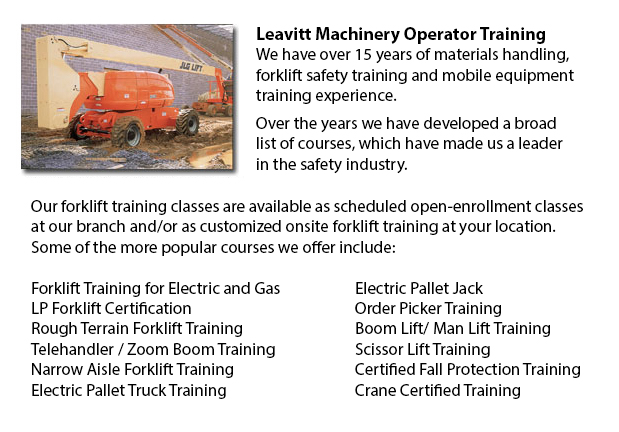
Sudbury Boom Lift Safey Training - Boom lifts fall under the kind of aerial lifting device or elevated work platform. Most commonly used in industry, warehousing and construction; the boom lift is really versatile that it can be utilized in virtually whatever surroundings.
Elevated work platforms enable personnel to access work places that will be unreachable otherwise. There is inherent risk in the operation of these devices. Workers who operate them need to be trained in the right operating techniques. Accident avoidance is vital.
Boom Lift Training Programs cover the safety factors involved in boom lift operation. The program is best for those who operate self-propelled elevated work platforms and self-propelled boom supported elevated work platforms. Upon successful completion of the course, People who participated will be given a certificate by someone licensed to confirm the completion of a hands-on assessment.
Industry agencies, federal and local regulators, and lift manufacturers all play a role in providing information and establishing standards to be able to help train operators in the safe use of elevated work platforms. The most essential ways to prevent accidents connected to the use of elevated work platforms are as follows: inspecting machines, putting on safety gear and conducting site assessment.
Important safety considerations when operating Boom lifts:
Operators stay away from power line, observing the minimum safe approach distance (MSAD). Voltage can arc across the air to be able to find an easy path to ground.
A telescopic boom should be retracted prior to lowering a work platform so as to maintain stability as the platform nears the ground.
Boom lift workers should tie off to guarantee their safety. The harness and lanyard contraption need to be attached to manufacturer provided anchorage, and never to other poles or wires. Tying off may or may not be required in scissor lifts, depending on specific employer guidelines, job risks or local rules.
The maximum slope will be specified by the manufacturer. Workers must avoid working on a slope, whenever possible. When the slope exceeds recommended situation, the lifting device must be winched or transported over the slope. A grade could be easily measured by laying a minimum 3-feet long straight edge or board on the slope. After that a carpenter's level can be laid on the straight edge and the end raised until it is level. The percent slope is attained by measuring the distance to the ground (also referred to as the rise) and then dividing the rise by the length of the straight edge. Then multiply by one hundred.
-
Wheel and Track Loader Training in Sudbury
Lift trucks are obtainable in several different models that have different load capacities. The majority of average forklifts used in warehouse environment have load capacities of 1-5 tons. Bigger scale units are utilized for heavier loads, like for... More -
Sudbury Aerial Lift Certification
Sudbury Aerial Lift Certification - Aerial Lift Certification is for individuals who requires an in-depth understanding of aerial lift safety. Inspectors and operators, supervisors, maintenance workers and construction craftsmen must perform a traini... More -
Sudbury Forklift Certification Schools
Sudbury Forklift Certification Schools - Within North America, forklift certification is mandatory, making forklift training programs necessary for both the company and their employees working as forklift operators. Forklift training focuses on healt... More -
Sudbury Boom Lift Operator Training
Sudbury Boom Lift Operator Training - A cherry picker refers to a type of aerial work platform. Cherry pickers include a platform or bucket at the end of a hydraulic lifting system. The device is likewise called a man lift, boom lift, basket crane or... More -
Sudbury Telehandler Certification
Sudbury Telehandler Certification - Telehandler certification programs are both for operators who have some experience driving a standard forklift and for those with no experience. The real-world training offered by these courses produces graduates w... More -
Operator Safety Training, Re-Qualification Training, In-House Instructor Training in Sudbury
Lift trucks are utilized in just about all industrial construction sites and in warehouse operations and in boat yards. The reach feature of a lift truck is a vital component used in several applications like for example when a shelving system is bei... More -
Crane / Overhead Crane / Self-Erect Crane / Truck Mounted Crane / Hydraulic Cranes Training in Sudbury
Bridge cranes or overhead cranes are a type of industrial material handling crane making use of a line and hook apparatus which runs on a horizontal beam running along two widely separated rails. Lots of overhead cranes could be seen in a long factor... More -
Sudbury Forklift Safety Training
Sudbury Forklift Safety Training - Anyone who wants to operate a lift truck should take a forklift safety training course in order to become a certified forklift truck operator. There are a variety of ways to obtain forklift training. Programs are pr... More

Forklift Certification Sudbury
TOLL FREE: 1-888-254-6157
Sudbury, Ontario
forkliftcertificationsudbury.com
Email Us
About Us


